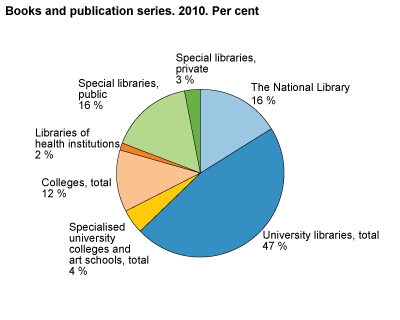Content
Published:
This is an archived release.
Decrease in books and publication series
In 2010, special and research libraries had a decrease in the number of books and publication series of 660 000, or three per cent. Nevertheless, lending by the public has risen by 160 000, or three per cent, since 2009.
|
The figure for non-local loans comprises field 152 from the statistics form, and the figure for loans comprises the figure from field 153. The figure for non-local loans and loans is therefore slightly too high. |
The number of books and publication series was 19.9 million, which is the first time since 2005 it has been below 20 million. The main decrease since 2009 was at libraries of health institutions and university libraries, with 11 and 8 per cent respectively. The university libraries still had the chief part of books and publication series, with 47 per cent of the total.
A rise in lending by the public
Special and research libraries made almost 4.8 million loans to the public in 2010; an increase of 3 per cent since 2009. In the last 10 years, total loans have risen by almost one million.
In 2010, there were 4.1 million local loans and 670 000 non-local loans. This is an increase of 3 per cent and 9 per cent respectively since 2009. The National Library had the highest share of non-local loans, with 78 per cent. At the other library types, non-local loans constitute between 7 and 11 per cent.
Tables:
Contact
-
Elisabeth Haraldsrud
E-mail: elisabeth.haraldsrud@ssb.no
tel.: (+47) 40 81 15 00
-
Line Gjermshusengen
E-mail: line.gjermshusengen@ssb.no
tel.: (+47) 40 81 13 46
-
Hilde Sofie Frydenberg
E-mail: hilde.frydenberg@ssb.no
tel.: (+47) 40 81 13 50

